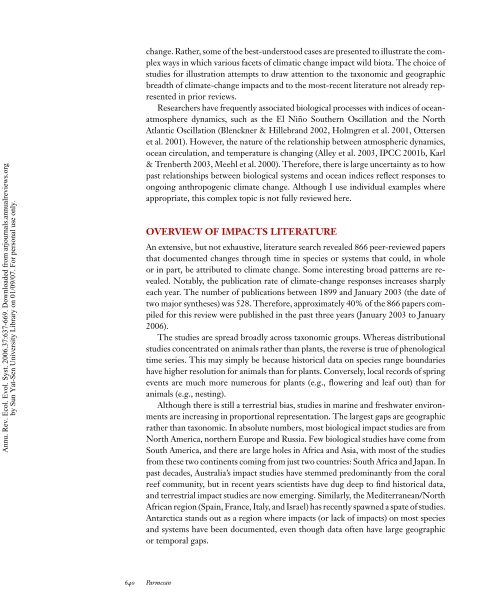Ecological and Evolutionary Responses to Recent Climate Change
Ecological and Evolutionary Responses to Recent Climate Change
Ecological and Evolutionary Responses to Recent Climate Change
Create successful ePaper yourself
Turn your PDF publications into a flip-book with our unique Google optimized e-Paper software.
Annu. Rev. Ecol. Evol. Syst. 2006.37:637-669. Downloaded from arjournals.annualreviews.org<br />
by Sun Yat-Sen University Library on 01/09/07. For personal use only.<br />
change. Rather, some of the best-unders<strong>to</strong>od cases are presented <strong>to</strong> illustrate the complex<br />
ways in which various facets of climatic change impact wild biota. The choice of<br />
studies for illustration attempts <strong>to</strong> draw attention <strong>to</strong> the taxonomic <strong>and</strong> geographic<br />
breadth of climate-change impacts <strong>and</strong> <strong>to</strong> the most-recent literature not already represented<br />
in prior reviews.<br />
Researchers have frequently associated biological processes with indices of oceanatmosphere<br />
dynamics, such as the El Niño Southern Oscillation <strong>and</strong> the North<br />
Atlantic Oscillation (Blenckner & Hillebr<strong>and</strong> 2002, Holmgren et al. 2001, Ottersen<br />
et al. 2001). However, the nature of the relationship between atmospheric dynamics,<br />
ocean circulation, <strong>and</strong> temperature is changing (Alley et al. 2003, IPCC 2001b, Karl<br />
& Trenberth 2003, Meehl et al. 2000). Therefore, there is large uncertainty as <strong>to</strong> how<br />
past relationships between biological systems <strong>and</strong> ocean indices reflect responses <strong>to</strong><br />
ongoing anthropogenic climate change. Although I use individual examples where<br />
appropriate, this complex <strong>to</strong>pic is not fully reviewed here.<br />
OVERVIEW OF IMPACTS LITERATURE<br />
An extensive, but not exhaustive, literature search revealed 866 peer-reviewed papers<br />
that documented changes through time in species or systems that could, in whole<br />
or in part, be attributed <strong>to</strong> climate change. Some interesting broad patterns are revealed.<br />
Notably, the publication rate of climate-change responses increases sharply<br />
each year. The number of publications between 1899 <strong>and</strong> January 2003 (the date of<br />
two major syntheses) was 528. Therefore, approximately 40% of the 866 papers compiled<br />
for this review were published in the past three years (January 2003 <strong>to</strong> January<br />
2006).<br />
The studies are spread broadly across taxonomic groups. Whereas distributional<br />
studies concentrated on animals rather than plants, the reverse is true of phenological<br />
time series. This may simply be because his<strong>to</strong>rical data on species range boundaries<br />
have higher resolution for animals than for plants. Conversely, local records of spring<br />
events are much more numerous for plants (e.g., flowering <strong>and</strong> leaf out) than for<br />
animals (e.g., nesting).<br />
Although there is still a terrestrial bias, studies in marine <strong>and</strong> freshwater environments<br />
are increasing in proportional representation. The largest gaps are geographic<br />
rather than taxonomic. In absolute numbers, most biological impact studies are from<br />
North America, northern Europe <strong>and</strong> Russia. Few biological studies have come from<br />
South America, <strong>and</strong> there are large holes in Africa <strong>and</strong> Asia, with most of the studies<br />
from these two continents coming from just two countries: South Africa <strong>and</strong> Japan. In<br />
past decades, Australia’s impact studies have stemmed predominantly from the coral<br />
reef community, but in recent years scientists have dug deep <strong>to</strong> find his<strong>to</strong>rical data,<br />
<strong>and</strong> terrestrial impact studies are now emerging. Similarly, the Mediterranean/North<br />
African region (Spain, France, Italy, <strong>and</strong> Israel) has recently spawned a spate of studies.<br />
Antarctica st<strong>and</strong>s out as a region where impacts (or lack of impacts) on most species<br />
<strong>and</strong> systems have been documented, even though data often have large geographic<br />
or temporal gaps.<br />
640 Parmesan
















